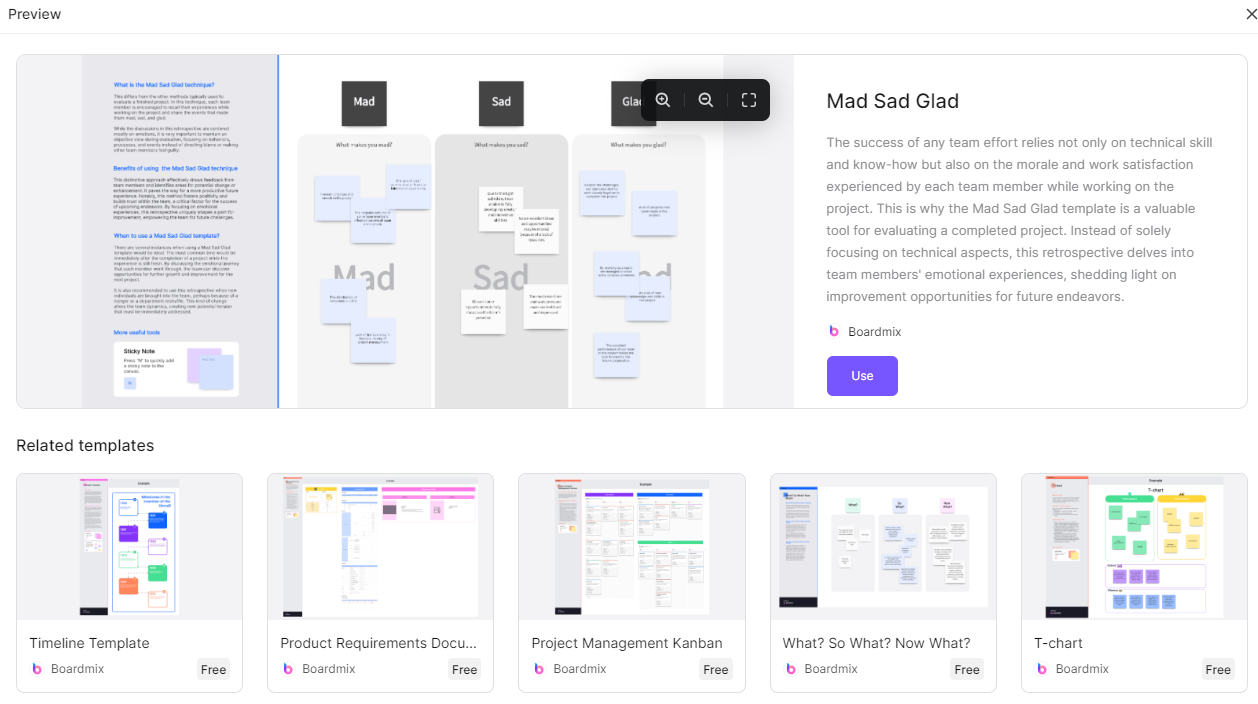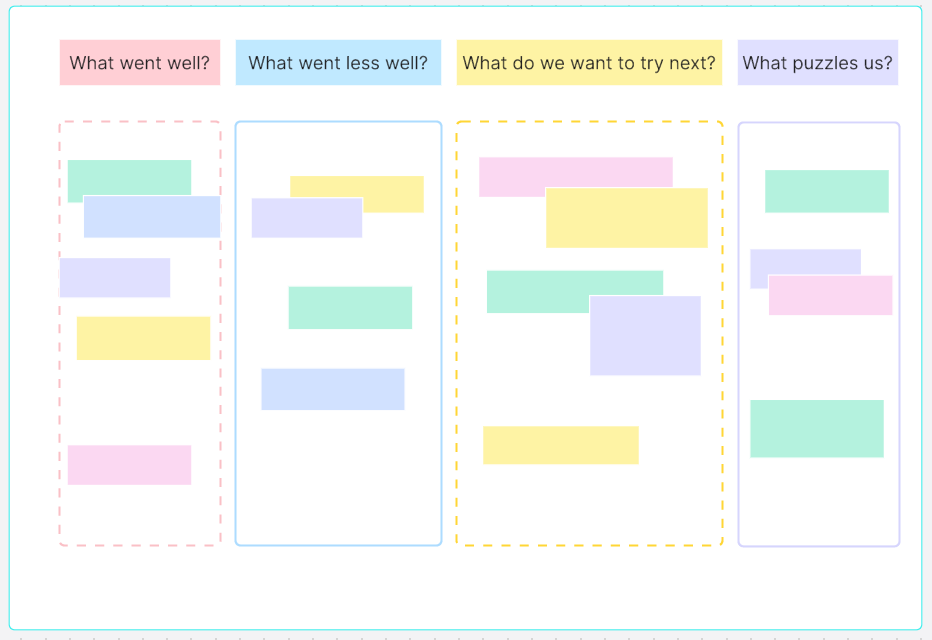This article explores how to effectively conduct a Mad Sad Glad retrospective using Boardmix, highlighting the tool's features, step-by-step guidance, and best practices for fostering Agile team improvement.

Introduction to the Mad Sad Glad Retrospective
In the dynamic world of Agile project management, retrospectives are pivotal in driving continuous improvement and agile team cohesion. One popular retrospective technique is the Mad Sad Glad retrospective. This method encourages team members to reflect on their emotional responses to different aspects of a sprint or project, providing insights that can lead to actionable improvements.
The Mad Sad Glad retrospective is structured around three emotional categories:
- Mad: Identifying elements that caused frustration or anger.
- Sad: Highlighting aspects that led to disappointment or sadness.
- Glad: Recognizing what made the team happy or proud.
By openly discussing these emotions, teams can uncover underlying issues, celebrate successes, and set a course for future improvements. Boardmix, an online whiteboard tool, offers a seamless platform for conducting such retrospectives, making it easier for teams to collaborate and visualize their thoughts.
Benefits of a Mad Sad Glad Retrospective

The Mad Sad Glad retrospective provides several key benefits:
1. Enhanced Emotional Awareness: Encouraging team members to express their feelings can lead to a better understanding of agile team dynamics and individual experiences.
2. Improved Communication: Facilitating open discussions helps break down communication barriers, fostering a more open and honest work environment.
3. Actionable Insights: Identifying specific issues and successes enables teams to implement targeted improvements.
4. Team Bonding: Sharing emotions can strengthen team bonds and build a more supportive work culture.
5. Celebration of Success: Recognizing positive outcomes boosts morale and motivates the team to maintain high performance.
By leveraging Boardmix's features, agile teams can enhance these benefits, making the retrospective process more engaging and productive.
Step-by-Step Guide to Conduct a Mad Sad Glad Retrospective with Boardmix

1. Set Up Your Boardmix Workspace
Begin by creating a new Boardmix workspace for your retrospective. Boardmix provides a variety of templates, including one specifically designed for the Mad Sad Glad retrospective. This template is pre-structured with three columns labeled Mad, Sad, and Glad, making it easy to get started.
2. Invite Team Members
Boardmix allows you to invite team members to your workspace via email or a shared link. Ensure all relevant team members are present to provide a comprehensive view of the sprint or project.
3. Explain the Process
Start the retrospective by explaining the purpose and structure of the Mad Sad Glad exercise. Clarify the three emotional categories and encourage everyone to think about specific events or aspects of the project that fit into each category.
4. Collect Feedback
Ask team members to write their thoughts on virtual sticky notes provided in the Boardmix template. Each note should correspond to one of the Mad, Sad, or Glad categories. This step can be done individually or collaboratively, depending on the team’s preference.
5. Group and Discuss
Once all feedback is collected, group similar notes together to identify common themes. Boardmix’s drag-and-drop functionality makes this process intuitive and efficient. Discuss each group of notes, allowing team members to elaborate on their points and provide additional context.
6. Identify Action Items
After discussing the themes, identify specific action items to address issues or build on successes. Assign these action items to team members and set deadlines. Boardmix’s task management features can help track these action items, ensuring accountability and follow-through.
7. Close the Retrospective
Conclude the retrospective by summarizing the key takeaways and expressing appreciation for everyone’s participation. Highlight any positive outcomes from previous retrospectives to reinforce the value of this practice.
Tips for Running a Mad Sad Glad Retrospective
To maximize the effectiveness of your Mad Sad Glad retrospective, consider the following tips:
1. Create a Safe Environment
Ensure that the retrospective is a safe space where team members feel comfortable sharing their honest thoughts. Emphasize that the goal is to learn and improve, not to assign blame.
2. Encourage Participation
Actively encourage all team members to contribute. Use Boardmix’s anonymous note feature if needed to help shyer team members share their thoughts without fear of judgment.
3. Be Specific
Encourage team members to provide specific mad sad glad retrospective examples rather than vague statements. This specificity can lead to more actionable insights.
4. Timebox Each Segment
Keep the retrospective focused and efficient by timeboxing each segment. Allocate specific times for individual note-writing, group discussions, and action item identification.
5. Follow Up
Ensure that action items identified during the retrospective are tracked and followed up on. Boardmix’s integration with project management tools can help maintain visibility and accountability.
Examples and Best Practices for Using Mad Sad Glad in Agile Teams
Example 1: Improving Sprint Processes

An Agile team using Boardmix for their Mad Sad Glad retrospective identified that they were often frustrated by unclear sprint goals (Mad), felt disappointed when work was delayed by external dependencies (Sad), and were pleased with their ability to collaborate effectively despite remote work challenges (Glad). By discussing these points, the team decided to improve sprint planning sessions to clarify goals and to establish better communication with external stakeholders to mitigate delays. The success of their remote collaboration was celebrated with a team virtual coffee break.
Example 2: Enhancing Team Morale

A software development team used the Mad Sad Glad retrospective to address a period of low morale. Team members expressed frustration over long working hours (Mad), sadness about missing project milestones (Sad), but happiness about the supportive team culture (Glad). The team decided to implement regular check-ins to manage workloads better and celebrated their supportive culture by sharing positive feedback during meetings.
Best Practices:
1. Regular Cadence: Conduct retrospectives regularly to maintain a steady rhythm of reflection and improvement.
2. Rotate Facilitation: Rotate the facilitator role among team members to bring fresh perspectives and shared ownership.
3. Visual Engagement: Use visuals and color-coding in Boardmix to make the retrospective more engaging and to highlight key themes.
4. Action-Oriented: Focus on identifying concrete actions that can be implemented before the next retrospective.
Conclusion
The Mad Sad Glad retrospective is a powerful tool for Agile teams aiming to enhance their processes, communication, and overall performance. This method encourages team members to reflect on their emotional responses to different aspects of a sprint or project, providing insights that can lead to actionable improvements and fostering a culture of continuous learning and collaboration.
By leveraging Boardmix’s intuitive and collaborative platform, teams can conduct these retrospectives more effectively and efficiently. Boardmix offers features such as customizable templates, virtual sticky notes, and integrated task management, which collectively enhance the retrospective experience. These tools make it easier to uncover insights, track action items, and implement improvements. Embrace the Mad Sad Glad retrospective with Boardmix to foster a more reflective, communicative, and high-performing team culture.








